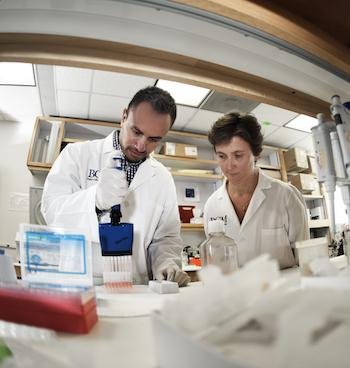Baylor College of Medicine researchers Redwan Huq, left, and Christine Beeton work on delivery methods for nanoparticles that may stop autoimmune responses linked to chronic conditions while not destroying the immune system as current standard therapies do. Photo by Agapito Sánchez Jr./Baylor College of Medicine
HOUSTON, Sept. 22 (UPI) -- Temporary tattoos delivering targeted treatments may be the future for better treatment of chronic conditions, based on a new concept by scientists.
Researchers at Baylor University and Rice University report nanoparticles delivered from just under the skin can turn off certain immune cells while not dampening the entire immune system and risking additional infection or adverse health effects, according to a proof-of-concept study published in the journal Scientific Reports.
Autoimmune disorders such as multiple sclerosis, caused by the immune system misidentifying healthy non-diseased tissue and attacking it, are often treated using immunosuppressants.
The drugs act as a broad bludgeon to the system, stopping T and B cells and macrophages needed to maintain health. A method of treatment that chases only the cells responsible for the autoimmune condition would be preferable, researchers involved with the new study say.
"They're going to affect all of these cells, but patients are exposed to side effects [ranging] from infections to increased chances of developing cancer," Redwan Huq, a graduate student at Baylor University and lead author of the study, said in a press release. "So we get excited when we see something new that could potentially enable selectivity."
Researchers at Rice University have previously designed nanoparticles that combine polyethylene glycol with hydrophilic carbon clusters -- referred to as PEG-HCCs -- which scavenge reactive oxygen species called superoxide molecules. The superoxides are used by T cells to become activated, but the PEG-HCCs remove the superoxide, preventing them from activating in a defensive mode, without killing them.
In the proof-of-concept study by researchers at Baylor, a method of delivering the nanoparticles under the skin was developed, but it leaves a visible spot on the skin that looks a like a tattoo.
The researchers suggest, if the method is proven useful, temporary tattoos could be used to hide the mark, which they say may be seen as a perk to some patients.
Although more research is needed to test the delivery method, as well as the safety and efficacy of the nanoparticles, but the researchers say both have the potential to improve treatment of conditions that are currently significantly difficult to deal with.















